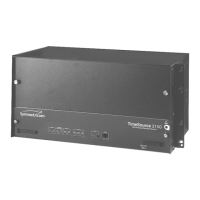1
TimeSource 3100 113
TL1 Reference
097-72020-01 Issue 9: November 2003
2
5
3
SSSSSSSSSSSS SSSS S SSSSS SSSS SSS S SSS S SSSSS
44
Parameters
The parameters that may be used in commands, responses, and messages are defined in
Table J. When a parameter uses the same values in every instance, those values are listed
with the parameter in the table. When the context requires different values for a parameter,
the value is listed with the parameter in the applicable commands, responses, and messages.
Table J. Parameter Definitions
Parameter Definition
<aid> Access identifier for the object of the command or message. It may
have more than one part.
<almcde> Alarm code. Identifies the severity of the alarm based on its priority
of action. If multiple alarms are reported, almcde is the highest
severity of those reported.
<alt> Antenna location altitude in meters, specified to the thousandth of a
meter, referenced to mean sea level, in the format mm.mmm.
<atag> Automatic message tag. It is incremented by one for each
autonomous message. The <atag> value is a whole number from
001 through 999, which is reset to 001 at reset or when it rolls over.
<command> Echo of the entered command.
<conddescr> Text description of the condition. The <conddescr> value is limited
to 64 characters starting and ending with a backslash and a double
quotation mark (\"). Refer to the Troubleshooting chapter of this
manual for the list of values.
<condeff> Effect on the condition of the equipment.
<condtype> Type of alarm condition.
<ctag> Correlation tag used to correlate input and response messages.
The ctag contains 1 to 6 characters. It must be included in a
command, and the same ctag is returned in the response.
<date> Current date in the 8-digit form: yyyy-mm-dd (command) or
yyyy:mm:dd (response or message), where yyyy is the year, mm is
the month (01-12), and dd is the day of the month (01-31). For
example, May 3, 2000 is 2000-05-03.

